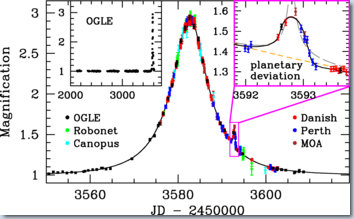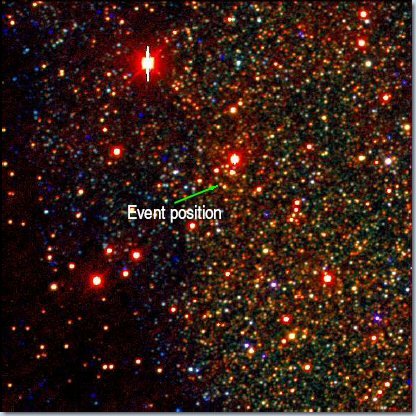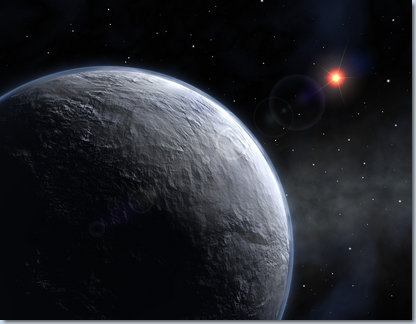|
The planet was discovered by using the microlensing technique which is based on a prediction by Einstein: light beams are attracted due to the gravitation of other stellar bodies and are thus distracted from their straight direction. However, this effect is in most cases incredibly small. But if a dim, intervening star can be used as a giant natural telescope, the more distant star can be magnified and temporarily looks brighter. The exact process of becoming symmetrically brighter and darker is mathematically well documented. If this brightened star is no single star but is accompanied by a planet this symmetrical "light curve" shows a short deviation with a further maximum. Thus the planet, although it cannot be seen from Earth, can be recognized. The distance of this extrasolar planet system is huge: it is about 22,000 light years away from us. Thus a further examination of the planet is nearly impossible.
Three independent microlensing campaigns were involved in the discovery: PLANET/RoboNet, OGLE and MOA. This includes 73 scientists at 32 institutes in 12 countries (Germany, France, Great Britain, Poland, Denmark, Austria, Chile, Australia, New Zeeland, USA, South Africa and Japan). Involved scientists from Germany are Dijana Dominis from the Astrophysikalische Institut Potsdam (AIP), Daniel Kubas from the Universität Potsdam, Joachim Wambsganss and Arnaud Cassan from the Zentrum fuer Astronomie der Universität Heidelberg (ZAH) as well as Martin Dominik. "Only good cooperation, coordination and strong dedication allowed this discovery after 10 years of research" explains Dominis.
OGLE-2005-BLG-390Lb is the third planet to be discovered by the microlensing technique. Different methods prefer different kinds of planets and stars which exist in different abundances. The relatively low yield is due to the fact that the microlensing effect favours gas giants like jupiter around red dwarfs which can be discovered relative easily but are very rare. However, only two of the found planets are gas giants. The discovery of OGLE-2005-BLG-390Lb as the third planet indicates a relative abundance of planets which are lighter than the outer ice planets Uranus and Neptun. This confirms our theories of planet formation.
These microlensing events are extremely rare: at most one among a million stars is enhanced by gravitation. Thus astronomers introduced a division of work: one group, the "OGLE team", regularly measures the brightness of 10 million stars (about twice a week). If one of them shows a change in brightness characteristic for the microlensing effect, an "e-mail alarm" is send to interested scientists, last year there were 600 of them. The PLANET team specializes in regularly measuring these lense events, ideal is several times per hour in order to exactly determine the progress of the light curve and possible deviations. This can only be achieved by a combination of four telescopes in the southern hemisphere: Tasmania, Western Australia, South Africa and Chile. Thus it is guaranteed that this star is measured for 24 hours. Thereby the astronomers have a "24 hours night shift": at any time it is night in one of these places!
On August 10, 2005 it happened: the microlensing event OGLE-2005-BLG-390 showed a short deviation when it went back to its normal brightness. So far it had scarcely deviated from its maximum which was 3 times above normal. This second maximum exactly progressed as is expected from a planet. However, it lasted only 15 hours. The considerably deviating break points were confirmed by 5 different observatories: the result was real. The analysis and modelling of the dates yielded only one result: a companion of the main lens star which has only 0.00008 as much mass is responsible. No other possibility could explain these data.
Since the lens star itself is too weak to be seen directly its mass cannot be measured exactly: it is probably between 10% and 40% of the mass of the Sun whereby the most probable value is 20%. Thus the most probable value for the planet mass is 5.5 times the mass of the Earth. The distance of the planet to its parent star is about 2.6 times the distance between Earth and Sun. thus it needs about 10 Earth years for one revolution.

Light curve of the microlens event OGLE-2005-BLG-390Lb where the planet caused a second maximum. The horizontal axis covers a period of 70 days; the magnified part in the upper right corner covers only 2 days. (Graph: PLANET group) |
[Press release (German)]
[Press release at ESO (English)]
[Press release at ZAH (German)]
[Article in "Nature"]
[Media page at Perth Observatory]
[Astrophysics at Potsdam University]
[AIP home page]
|
|

The observing field in the sky is close to the center of the Milky Way. Only the background star is visible, the lens star and the planet are too weak to be visible. (Image: PLANET group)

Artist's view of the new planet OGLE-2005-BLG-390Lb and its parent star if it could be imaged (Photo: STSCI/G. Bacon).
|
Most of the so far known 170 planets around distant Suns have high masses (comparable to the one of Jupiter) and orbit their parent stars very closely. Thus they are called "hot Jupiters". Actually the astronomers had expected many planets with smaller masses ("rock or ice planets") and greater distances.
The particular importance of this discovery is the fact that the planet has the lowest mass from all known exoplanets. Thus it is the one most similar to Earth. Probably it is an icy or rocky planet resembling Earth, Venus and Mars. Astronomers think that this planet type should be much more common than the "hot Jupiters". OGLE-2005-BLG-390-Lb is the third planet found by means of the microlensing method: the masses of the previously found planets were slightly above Jupiter. Like for all methods, it is easier to find bigger planets. The fact that already one among three discovered planets has such a low mass indicates that they are much more common in our Milky Way.
The team leader, Dr Jean-Philippe Beaulieu from the Institut d'Astrophysique de Paris demands an expansion of the search with the microlensing effect with existing or additional ressources from Earth - or in the near future from a satellite: "The discovery of a rocky or icy planet which is lighter than Neptun or Uranus is a clear hint that more such planets will be discovered which is the first step to discovering another Earth".
Contact
Dijana Dominis
Astrophysikalisches Institut Potsdam
An der Sternwarte 16
14482 Potsdam
Tel.: (0331) 7499 284

Dr. Daniel Kubas
Universität Potsdam
Institut für Physik
Am Neuen Palais 10
14469 Potsdam
Tel.: (0173) 899 31 95

Prof. Joachim Wambsganß
Astronomisches Rechen-Institut
Mönchhofstr. 12-14
69120 Heidelberg
Tel.: (6221) 54 1801

|


 last change 2006 January 26, R. Arlt
last change 2006 January 26, R. Arlt


